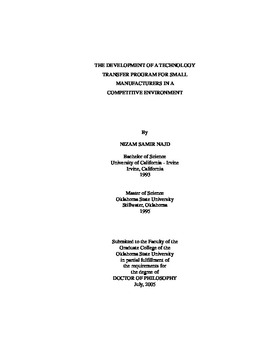| dc.contributor.advisor | Pratt, David B. | |
| dc.contributor.author | Najd, Nizam Samir | |
| dc.date.accessioned | 2013-12-10T18:05:05Z | |
| dc.date.available | 2013-12-10T18:05:05Z | |
| dc.date.issued | 2005-07 | |
| dc.identifier.uri | https://hdl.handle.net/11244/7777 | |
| dc.description.abstract | Scope and Method of Study: The purpose of this study was to determine the desirable technology transfer dimensions, attributes, approaches, programs, and processes and the desirable organizational structure which could be used to develop a state technology transfer program for small manufacturers in a competitive environment. A survey questionnaire was sent to 493 rural and metropolitan manufacturers across the state of Oklahoma in eight different SIC codes. The questionnaire consisted of 40 questions which determined the small manufacturers' attitudes towards technology transfer in a competitive environment. Frequency data analysis was used to gather detailed perspectives on the survey respondents operating under competitive pressures and filtering (cluster) analysis was used to further divide the survey respondents into 36 distinct technology transfer policy groups to infer additional in-depth technology transfer viewpoints regarding these 36 distinct combinations. | |
| dc.description.abstract | Findings and Conclusions: The frequency data analysis identified the top attributes in the five technology transfer dimensions to be: technical assistance - (communication access), research and development - (new product development), governmental compliance - (non-threatening governmental assistance), business assistance - (marketing study assistance and support), and human resource management - (employee benefits, insurance, and worker's compensation training). Three technology transfer approaches were important and were actively used. For three of the "top-ten" competitive pressures, the filtering analysis revealed that the majority of the small manufacturers were already on the most optimal decision path to successful technology transfer - (i.e., they preferred appropriate technology programs and technology adaptation processes). The technical assistance and research and development dimensions and the workforce skills and financing barriers were the predominant technology transfer characteristics faced by Oklahoma's small manufacturers in the applicable combinations found in the Nizam Pyramid. The Nizam Pyramid was a "metamodeling" approach developed to summarize the filtered data and to provide an overall representation of the organizational structure for Oklahoma's state-wide technology transfer program. | |
| dc.format | application/pdf | |
| dc.language | en_US | |
| dc.rights | Copyright is held by the author who has granted the Oklahoma State University Library the non-exclusive right to share this material in its institutional repository. Contact Digital Library Services at lib-dls@okstate.edu or 405-744-9161 for the permission policy on the use, reproduction or distribution of this material. | |
| dc.title | Development of a technology transfer program for small manufacturers in a competitive environment | |
| dc.contributor.committeeMember | Case, Kenneth E. | |
| dc.contributor.committeeMember | Rossler, Paul E. | |
| dc.contributor.committeeMember | Kiser, Kenneth J. | |
| osu.filename | Najd_okstate_0664D_1454.pdf | |
| osu.accesstype | Open Access | |
| dc.type.genre | Dissertation | |
| dc.type.material | Text | |
| thesis.degree.discipline | Industrial Engineering and Management | |
| thesis.degree.grantor | Oklahoma State University | |
